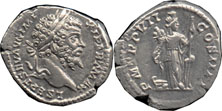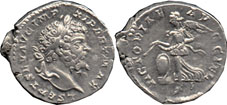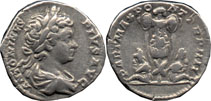Obverse: AVRELIVS CAESAR AVG PII F COS, bare head right.
Reverse: IVVENTAS, Iuventas standing left holding a patera (a shallow round dish used in sacrificing grain to the gods) and sprinkling incense over a candelabrum (a tapered column for the support of candles).
This issue refers to Aurelius' assumption of the "toga virilis", a white toga symbolizing manhood, in 140 AD. As per custom sacrifices were made at the shrine of Iuventas, the Roman goddess of youth and specifically of young men of military age. This shrine was located at the Circus Maximus, the chariot-racing center of Rome.


Obverse: L SEPT SEV AVG IMP XI PART MAX, laureate head right.
Reverse: PM TR P VII COS II PP, Fortuna or Abundantia standing left before a prow, holding a cornucopiae and rudder.
The reverse of this coin shows either Fortuna or Abundantia, both goddesses of prosperity, abundance and good fortune, though Fortuna later became the goddess of the more arbitrary fate and chance. Severus renewed his tribunician power for the seventh time (TR P VII) in 199 AD, dating this coin from that year.


Obverse: L SEPT SEV AVG IMP XI PART MAX, laureate head right.
Reverse: VICTORIAE AVGG FEL, Victory walking left.
The representation of Victory may indicate the success of a specific campaign, or, as likely in this case, represents the generic prowess of the emperor. At the time of Severus, a military victory conferred upon the emperor an imperial acclamation - the eleventh of these (IMP XI) dates the coin to between 198 and 211 AD. Two Gs in AVGG indicate two concurrent rulers - it is likely the second G refers to his son Carcalla, who ruled with him from 198 to 209 AD.


Obverse: ANTONINVS PIVS AVG, draped and laureate bust right.
Reverse: PART MAX PONT TR P IIII, a trophy with two captives seated at its base.
This denarius of Carcalla was struck to commemorate the victory over the Parthians, a rival to Rome in the control of the Middle East west of the Euphrates, in 198 AD. As he renewed the tribunician power for the fourth time (TR P IIII) in 201 AD, this coin was likely struck that year. This portrait is the young head style - as he was born in 188AD, he was only 13 at the time of the striking of this coin.


Obverse: IMP ANTONINVS AVG, draped and laureate bust right.
Reverse: PM TR P II COS II PP, Pax running left holding an olive branch and a scepter.
Pax was the goddess of peace, and as with the issue of Victory above may represent the general state of the empire rather than the result of a specific conflict. This coin as well can be specifically dated - Elagabalus renewed the tribunician power for the second time (TR P II) in 219 AD.
